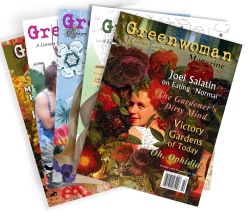Last week I wrote about our family’s old stove, a stove I used while our children were young, while we were all growing up. It was a charming 1930s model, and we loved her, but as time went by things changed. As we approach the holiday season with the accompanying cooking and family gatherings, a tale of kitchen friends, past and present, seems appropriate. This is the second half of “Stove Love,” written four years ago.
* * *
Stove Love – Part II
It’s spring again, almost a decade since my first ode to the other stove. She’s just been moved to the front porch, newly (but by no means perfectly) scrubbed, awaiting the next chapter of her life. We’re not sure what that will be, if we’ll sell or keep her, as quick decisions are not a hallmark of our household. Andy and I are pokey, often impractical, romantics. At first I thought I couldn’t bear to part with her. Maybe I’d use her as a potting table, fill the oven and storage drawers with planters and supplies. Then I thought of the economy; with two girls headed for college sometimes it’s not such a great idea to hang on to the past. I scouted, briefly, for possible buyers on the internet, then became sidetracked with other concerns.
For a few days after we moved her from the kitchen I sulked and even resented my new used stove. Its plain-Jane practicality and efficiency mocked me. Less glamorous, less fun. I saw it as a mirror held up to my life—you are getting old and boring, practical; you’re selling out romance.
The 1930s stove, like me, was showing her wear. After twenty-some years in our family the chips in her pretty green-marbled and yellow enamel had grown bigger, dings now dime-sized, quarter-sized pits enlarged to silver dollars, the rusty front drawer rustier, cast iron burners more clogged, the porcelain drawer pull showing more hairline cracks. Several years ago the oven door went sloppy, opening on its own at inopportune times. Baking meant adding a cardboard shim. The cardboard in the door became a temptation for Chancho, our wiry, naughty, Chihuahua-terrier mix. He would run off with the cardboard, requiring a repeat (grab a Celestial Seasoning box, tear off a piece, fold) every time we baked. Andy attempted a repair of the door with some wire; it worked for a time, then didn’t, and we blew off dealing with it. When you are using a seventy, eighty-year-old appliance, it’s easy to go with the “why bother” mentality.
So, while I was bonded with this stove, I had been growing impatient. There’s a certain charm (you’re oblivious to at the time) when you’re young—in driving beat up cars, dealing with the quirks of aging appliances. They’re only minor irritations, and it’s easy to not give too much of a damn because you’ve got your whole life ahead of you and things will get better, you’re sure of that. But then the years fly by and when life doesn’t produce that voila! magic transformation that you’ve dreamed of (though life is still good), there comes a drop in tolerance. Eighty-year-old stoves with crap doors aren’t so charming. The sour thought that a new stove would be nice starts to occur to you; that it’d be real damn nice not to have to put this freaking cardboard in the door every time you bake muffins. But you look at hubby and he, God knows, has enough to deal with, too—so you check the nagging.
When I was a teenager my five younger siblings and I would come home from school, scavenge a snack, and gather around the TV for after-school-recovery-time, right before get-the-chores-done-before-Mom-comes-home time. Gilligan’s Island and The Brady Bunch were our usual fare, but sometimes we’d zone out to the materialistic antics of the contestants on The Price is Right. We didn’t really like the show, and I wondered at the lame displays some of the winners made regarding, to my mind, hopelessly boring prizes, like appliances. They’d jump up and down, some quaking, or even, if you can imagine, crying, at the glorious sight of a new refrigerator or washer/dryer combo, previously fondled by one of Bob Barker’s beatific bimbos. “What the f?” wasn’t in my vocab in the late 70s, but that was my reaction. Then I grew up, became a homeowner, and learned that reliable appliances were pretty nice indeed. Especially after you’ve spent some time in a laundromat with a baby, or, even more fun, pregnant, with a toddler running around the laundromat as you fold clothes. If you’ve experienced the joys of defrosting a non-frost-free freezer with a hair dryer you will know whereof I speak.
So it was just the natural progression of life and not really old-fogey-ism when a rush of excitement came upon me when Andy, working on a home remodel in our wealthiest part of town, told me that there might be a great stove up for grabs.
“What kind?” I asked, although a very precise picture had formed in my mind. With money came quality. I flashed on stoves I’d coveted over the years in decorating magazines . . . stainless steel, definitely . . . with badass names like Viking and Wolf. Stoves that could withstand the lightning bolts of Thor, that could cook Grandma whole.
“It’s stainless steel, a four burner, with an electric convection oven.”
My pulse quickened. “Is it a . . . ” I stammered, dared to hope, “a Viking?”
“No, some other brand.” Andy told me that not all the best stoves were Viking, never mind the advertising campaigns.
I didn’t know exactly what a convection oven was, but I knew this might be my dream stove. I didn’t get my hopes up, though. Several weeks went by. Andy negotiated with the contractor. He researched the brand on the Internet (a damned fine stove, indeed!). I held my breath. It looked like we’d probably get it and then, no, the contractor’s son wanted it. That was that. No new used stove for me.
I was disappointed but not crushed. It didn’t surprise me that they wanted to keep it. Yet it did make it more difficult to fry my eggs on the old one.
Then, two years later, another turn of events (I told you things don’t happen fast around here). The contractor’s son decided to sell the stove. Andy could buy it, for a pretty penny but still a fraction of its value, and less than an ordinary stove. He would pick it up in Boulder, ninety miles away.
It was weird, changing them out. Next to the 1930’s beauty, this stove looked as tough as a womens’ prison guard. No nonsense. Boxy. Bulky. Black and silver. Her label was DCS—Dynamic Cooking Systems.
It took three of us to get her up the front stairs and into the kitchen. My shoulder hurt for days. She was ungodly heavy. Her oven door, with its glass window, was massive and it closed up tight as a safe.
Our two daughters weren’t exactly thrilled with the new stove, either, at first. One of Lily’s friends, Shelby, was especially disappointed. She loved the quirks—having to light the burners and oven with a lighter, the cardboard shim thing. She had known that stove since kindergarten, it had played a role in tea parties, and pancake breakfasts after sleepovers.
Our new stove had one broken knob, an injury during the first move (a replacement’s on order), and one of the burner sensors needed cleaning. Otherwise, she was in tip-top shape. Low mileage, as her previous owners were away most of the time. The streamlined ease with which she’s designed is admirable. A row of five tiny rubber buttons to push for: Off, Bake, Conv, Broil, Light. Four big black burner knobs which go from high flame to the tiniest simmer flame I have ever seen, a light (a light, what will they think of next!) in the oven. Three tiny red lights to indicate: Oven On, Heating, and Door Locked. Not super fancy, not slick, but so practical. We’ve tried her out, and it is a magnificent experience to cook with someone of her abilities.
She suits me pretty well and I’m gradually looking past the hard-edged exterior into the inner possibilities. The other night, after hours of shoveling dirt in our new community garden, I drifted off to sleep at about 7 p.m., in front of the TV with my work clothes on. When I awoke, Ruth Reichl (food writer extraordinaire) was on some PBS show talking about gardening and food. She was showing how to oven dry tomatoes—drying them to the point where they can be powdered, and then using this wonderful tasty ingredient on pasta, deviled eggs, etc. Although I am secretly scheming to get Andy to build a solar food dehydrator this year, I thought, excitedly, half-asleep, the possibilities bringing me to consciousness—I can do this this summer with home-grown tomatoes. This would be perfect in my new oven!
Zora, our oldest daughter, immediately came around to loving the new stove. “The rice cooks better,” she announced after preparing a dinner of Indian food, a once-a-week ritual she’s adopted this year. She was the first to bake with the new stove, making cupcakes for her classmates on her eighteenth birthday. They, too, were perfect. I’ve played with the convention aspect and marveled at the speediness, the evenness, the crispness it brings to bread crusts. This new girl can cook.
I know now that what really bothered me about the stoves, the whole out-with-the-old in-with-the-new, is that they symbolized the change in our home this year. While we’ll have a child at home for several more years, our family is growing up, getting older, and, like all transformations, all growth, it has not been easy or painless. Zora will leave this fall to college. While I always thought I would not be one of “those moms,” those overly-sentimental women falling apart when fledglings fly the nest (because, I imagined, they probably didn’t have enough going on in their life) I’ll be damned if I’m not one of those moms, when I let myself be. An era is ending, and I try not to dwell on it, because when I do I cannot help but to mourn. At the same time, I know I should be joyful that I have reared a perfect young woman, and I am, and yet . . . This will be a year of work for me, getting my mind and heart around it all, moving toward acceptance. This stove-change has reflected it all. A very pretty, albeit impractical and outrageous era draws to a close, yet I have grown, too, into a competent, secure, happy-with-her-life middle aged woman. I like who I am now. I am not as young and pretty, but I’m not as flakey, inexperienced, and filled with high drama either.
This new chapter in my life is one to look forward to—delicious new recipes, new experiments, and discoveries. Soon I know I will have a feeling—that I can’t wait to start cooking.
—Sandra Knauf

















